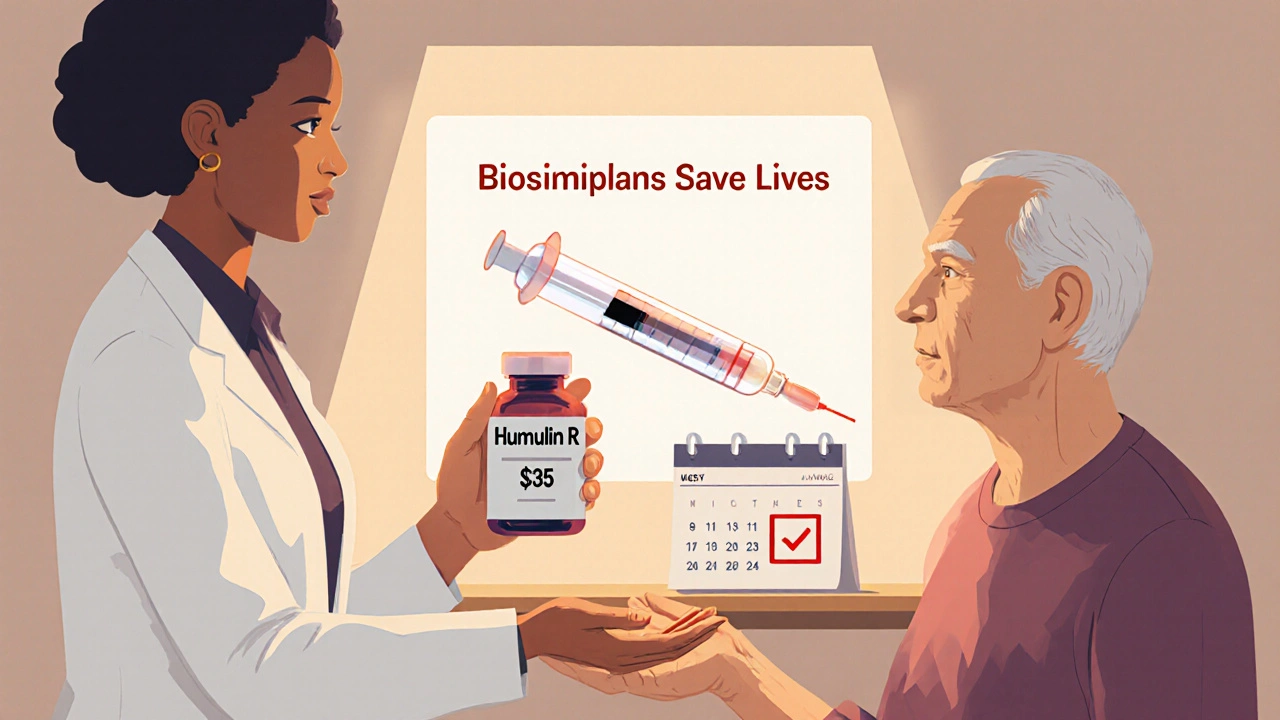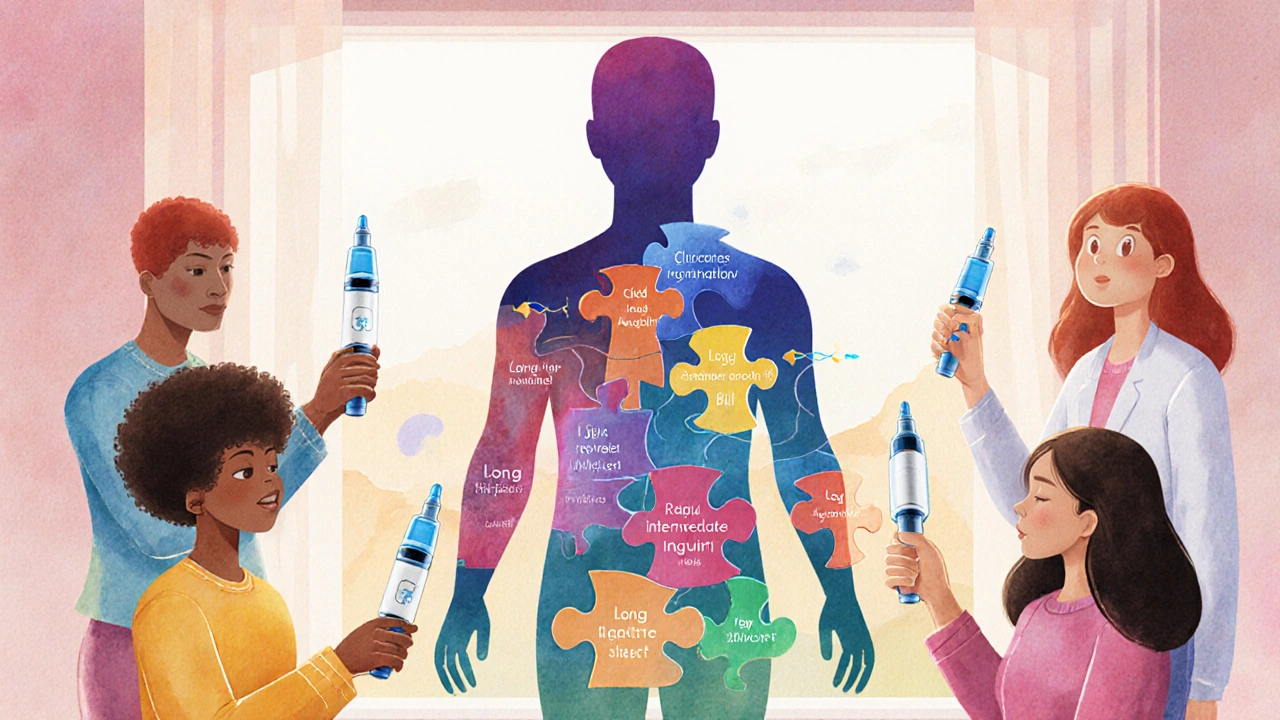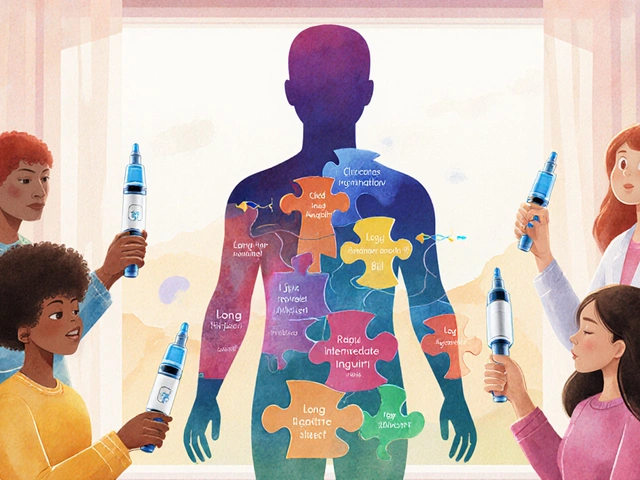Choosing the right insulin isn’t about picking the most advanced or expensive option-it’s about matching your life, your body, and your goals. For millions of people with diabetes, insulin isn’t just a drug; it’s the tool that keeps them alive and active. But with so many types and regimens, it’s easy to feel overwhelmed. The truth? There’s no one-size-fits-all solution. What works for someone else might not work for you-and that’s okay.
Understanding the Four Main Types of Insulin
Insulin comes in four main categories, each designed to do something specific: cover your background needs, handle meals, or both. The key is understanding how fast they start, when they peak, and how long they last.
- Rapid-acting insulins (like Humalog, NovoLog, and Apidra) kick in within 10-15 minutes, peak around 30-90 minutes, and wear off in 3-5 hours. These are your mealtime insulins. They’re ideal if you eat at irregular times or want tight control after carbs.
- Regular (short-acting) insulin (Humulin R, Novolin R) takes about 30 minutes to start working, peaks at 2-3 hours, and lasts up to 8 hours. It’s cheaper but less flexible. Many people still use it in hospitals or where cost is a barrier.
- Intermediate-acting insulin (NPH, like Humulin N) starts working in 1-2 hours, peaks between 4-12 hours, and lasts 12-18 hours. It’s often used twice daily to cover overnight and between meals. But because it has a strong peak, it increases the risk of nighttime low blood sugar.
- Long- and ultra-long-acting insulins (Lantus, Levemir, Toujeo, Tresiba) are your baseline. They don’t peak-they just keep working steadily. Tresiba (insulin degludec) lasts over 42 hours, giving you more flexibility with timing. These are the backbone of most modern regimens.
There’s also Afrezza, an inhaled insulin that works like rapid-acting but without needles. It starts in 12 minutes and lasts about 3 hours. Great for people with needle fear-but not for smokers, and it requires lung function checks.
Basal-Bolus: The Gold Standard for Type 1 Diabetes
If you have type 1 diabetes, your pancreas doesn’t make insulin at all. That means you need two kinds: one to cover your constant background need (basal), and one to handle food (bolus). This is called basal-bolus therapy.
Most doctors recommend combining a long-acting insulin (like Tresiba or Lantus) with a rapid-acting insulin at each meal. This mimics how a healthy pancreas works. Studies show this approach lowers A1C by 0.3-0.4% compared to older regimens and cuts hypoglycemia by 25%.
Some people use insulin pumps instead of multiple daily injections. Pumps deliver rapid-acting insulin continuously and allow for precise boluses. They’re especially helpful for people with unpredictable schedules or kids who need small, frequent doses. But they come with a learning curve and can be expensive. About 78% of pump users report high satisfaction-but 62% deal with site issues like irritation or dislodging.
Insulin for Type 2 Diabetes: It’s Not Always the First Choice
Many people with type 2 diabetes start with pills like metformin. But if your A1C stays above 9% or you’re losing weight despite high blood sugar, insulin becomes necessary. Here’s the shift in thinking: insulin isn’t always the first injectable anymore.
Guidelines now say to consider GLP-1 receptor agonists (like semaglutide) or SGLT2 inhibitors (like empagliflozin) before insulin-if you have heart or kidney disease. These drugs lower A1C, help you lose weight, and protect your organs. But if your blood sugar is dangerously high (above 9.5%), insulin works faster and more reliably.
When insulin is needed, many people start with once-daily long-acting insulin. It’s simple: one shot at night, no meal counting needed. If that’s not enough, you add rapid-acting insulin for meals. This stepwise approach reduces fear and makes the transition easier.
Cost Matters More Than You Think
Here’s the hard truth: insulin is still too expensive for many people. Even with the $35 monthly cap for Medicare, people on commercial insurance often pay $250-$350 per vial for analog insulins. Human insulin (like Humulin R or N) costs $25-$35 at Walmart’s ReliOn brand. That’s a 10x difference.
In 2023, 1 in 4 insulin users admitted to rationing-skipping doses, stretching vials, or going without. This isn’t just risky; it’s deadly. Rationing leads to DKA, hospital stays, and long-term damage.
Thankfully, biosimilars are coming. Semglee (a biosimilar to Lantus) is already available and costs about half as much. More are on the way. If you’re paying full price, ask your doctor about human insulin or biosimilars. They work just as well for many people.

Regimens That Fit Real Life
Regimen choice depends on your daily rhythm.
- Basal-bolus (MDI): Best for type 1, or type 2 with high carb intake. Requires carb counting and frequent blood sugar checks. Four to six shots a day.
- Twice-daily premixed insulin: Mixes intermediate and rapid-acting in one shot (like Humalog Mix 75/25). Convenient for people with routine meals. Less flexible if you skip lunch or eat late.
- Once-daily basal insulin: Simple, low-risk for lows. Good for older adults or those with cognitive challenges.
- Insulin pumps or closed-loop systems: The most advanced. Pumps deliver insulin continuously. Closed-loop systems (like MiniMed 780G) adjust insulin automatically based on CGM readings. A1C drops 0.5-1% compared to MDI. Best for motivated users.
One study found that people using hybrid closed-loop systems (pump + CGM) had A1C under 7% in 78% of cases. But these systems require daily maintenance and aren’t for everyone.
What Experts Say About Choosing
Dr. Richard Bergenstal, former ADA president, says analog insulins are preferred because they’re more predictable and cause fewer lows. But he also adds: “Cost shouldn’t be a barrier to safety.”
Dr. Silvio Inzucchi from Yale reminds us: “For type 2 diabetes, we don’t wait until insulin fails-we start with heart-protective drugs first.”
And Dr. Jane Reusch highlights inhaled insulin: “It’s not for everyone, but for someone terrified of needles, it’s life-changing.”
The bottom line? Don’t let fear or cost stop you from getting the right treatment. Talk to your care team. Ask about biosimilars. Ask about financial help programs. Your life depends on it.
Getting Started: Practical Steps
If you’re starting insulin, here’s what to do:
- Get a continuous glucose monitor (CGM). Even if you’re on injections, seeing your trends makes dosing way easier.
- Learn carb counting. Most people need 1 unit of rapid insulin per 10-15 grams of carbs. Start with that as a guess.
- Track your blood sugar before meals and 2 hours after. Look for patterns.
- Ask for a certified diabetes care and education specialist (CDCES). They’re trained to teach you how to adjust doses safely. Studies show they improve A1C by 0.5-1%.
- Don’t rush. It takes 6-12 weeks to get comfortable. Your first few weeks might feel messy. That’s normal.

What to Avoid
- Don’t use NPH if you’re prone to nighttime lows. It’s outdated for most people.
- Don’t skip doses because you’re scared of low blood sugar. Learn your correction factor (usually 1 unit lowers blood sugar by 30-50 mg/dL).
- Don’t assume insulin means failure. It’s just another tool. Many people with type 2 diabetes live better, longer lives once they start insulin.
- Don’t ignore cost. Ask about patient assistance programs from manufacturers. Many offer free insulin for eligible people.
What’s Next in Insulin Therapy
Big changes are coming. In 2024, the FDA approved the first once-weekly insulin-icodec. Early trials show it works as well as daily Tresiba, with slightly better A1C control. Imagine one shot a week instead of one a day. That’s huge.
Oral insulin is in phase 3 trials. If it works, it could replace injections for many. Smart insulins that respond to blood sugar levels are in early testing. These could auto-adjust without needing a pump.
But until then, the best insulin is the one you can afford, understand, and use consistently.
What’s the difference between human insulin and analog insulin?
Human insulin is made to match the insulin your body naturally produces. It’s older, cheaper, and works well-but it has a more unpredictable peak, which can cause low blood sugar. Analog insulins are chemically modified to act faster or last longer with fewer peaks. They’re more predictable and safer, especially at night, but cost 10-15 times more.
Can I switch from analog to human insulin to save money?
Yes, many people do. Human insulin (like Humulin R or N) works fine for many, especially if you have a regular schedule. But you’ll need to time meals more carefully and check blood sugar more often. Talk to your doctor first-dosing is different. Some people need 20-30% more units of human insulin than analogs.
Why do some people need more than one type of insulin?
Your body needs insulin all day, not just at meals. Long-acting insulin covers your background need (basal). Rapid-acting insulin covers spikes after eating (bolus). Using both mimics how a healthy pancreas works. Skipping one leads to highs or lows. Most people with type 1 and many with advanced type 2 need both.
Is insulin safe for older adults?
Yes, but caution is needed. Older adults are more sensitive to insulin and at higher risk for dangerous lows. Starting with low doses of long-acting insulin (like Tresiba) and avoiding rapid-acting unless necessary reduces risk. CGMs are especially helpful for this group. Simpler regimens (once-daily basal) are often best.
How do I know if my insulin regimen isn’t working?
If your A1C stays above 8% for 3-6 months despite following your plan, or if you’re having frequent lows (especially overnight), your regimen may need adjusting. Also, if you’re skipping doses because it’s too hard or expensive, that’s a sign you need a better fit. Talk to your care team. There’s always another option.
Next Steps
If you’re on insulin, schedule a check-in with your doctor or CDCES. Ask about CGMs, biosimilars, and cost-saving programs. If you’re not on insulin yet but your A1C is high, ask if you’re ready for it-or if a GLP-1 or SGLT2 drug might be better. Don’t wait until you’re in crisis. Insulin isn’t the end of the road-it’s a step toward better health.





Comments
So insulin is basically just a fancy life-support system for people who can't control their diet. I mean, why not just eat less sugar and stop being lazy? 🤷♂️
This is actually one of the clearest breakdowns I've seen. I appreciate how you laid out the trade-offs between cost, convenience, and control. It’s not about perfection-it’s about sustainability.
For anyone scared of needles, Afrezza is a game-changer. I know people who switched and finally stopped avoiding their labs.
The scientific rigor in this post is commendable. One must acknowledge the pharmacological distinctions between human and analog insulins with precision, as the pharmacokinetic profiles significantly influence glycemic variability. Furthermore, the economic disparity in access to biosimilars remains a critical public health concern in low-resource settings.
It is imperative that healthcare systems prioritize equitable distribution, as insulin rationing is not merely a personal failure but a systemic one.
I started on Lantus last year and honestly it was a nightmare at first but now I barely think about it. Just inject and go. The key is consistency not perfection.
Also if you're on a pump and hate the site irritation try Tegaderm under the adhesive. Game changer.
The idea that insulin is 'just another tool' is dangerously oversimplified. For many, it's a lifelong burden wrapped in needles, cost anxiety, and social stigma. This post reads like a pharmaceutical brochure disguised as empathy.
If you're still using NPH in 2024 you're not managing diabetes-you're performing a relic experiment. And don't get me started on people who think Humulin R is 'just as good'. It's not. It's dangerous. Period.
Insulin: the original subscription service 🤡 $35 for Medicare, $300 for everyone else. Guess who's the real villain here? Not the people who ration. The system.
The data presented regarding the efficacy of basal-bolus regimens compared to premixed insulins is statistically significant and clinically meaningful. Furthermore, the integration of continuous glucose monitoring with hybrid closed-loop systems demonstrates a paradigm shift in therapeutic outcomes. It is imperative that clinical guidelines evolve to reflect these advancements.
To anyone feeling overwhelmed-this isn’t a race. It took me nine months to get my dosing right. I cried a lot. I messed up. I rationed once because I couldn’t afford it. I’m not proud of that. But I kept going. And you can too.
Ask for help. There are people who want to give it to you.
I just need one shot a day. Why does it have to be so complicated?
People who say 'insulin isn't failure' are lying to themselves. If you need insulin, you failed at diet, failed at exercise, failed at prevention. Stop pretending it's just a tool. It's the consequence.
I’ve been on insulin for 18 years now. Started with NPH, moved to Lantus, now using Tresiba. It’s not about being perfect. It’s about showing up. Some days I’m on point. Some days I’m just trying not to pass out. That’s okay. You’re not alone.
There’s a quiet poetry in insulin-the way it hums beneath the skin, a silent rhythm of survival. It’s not just chemistry. It’s discipline. It’s love. It’s showing up for your future self when your present self is exhausted.
And yes, the cost is obscene. But the fact that we can even have this conversation-about biosimilars, pumps, inhaled insulin-is a miracle. We’ve come so far. We still have so far to go.
You mentioned Tresiba lasts over 42 hours. That’s technically incorrect. The half-life is 25 hours. The duration is based on steady-state accumulation. You’re conflating pharmacokinetics with clinical effect. Also, once-weekly insulin? More like once-weekly placebo until the real data comes out. Don’t get hyped by press releases.